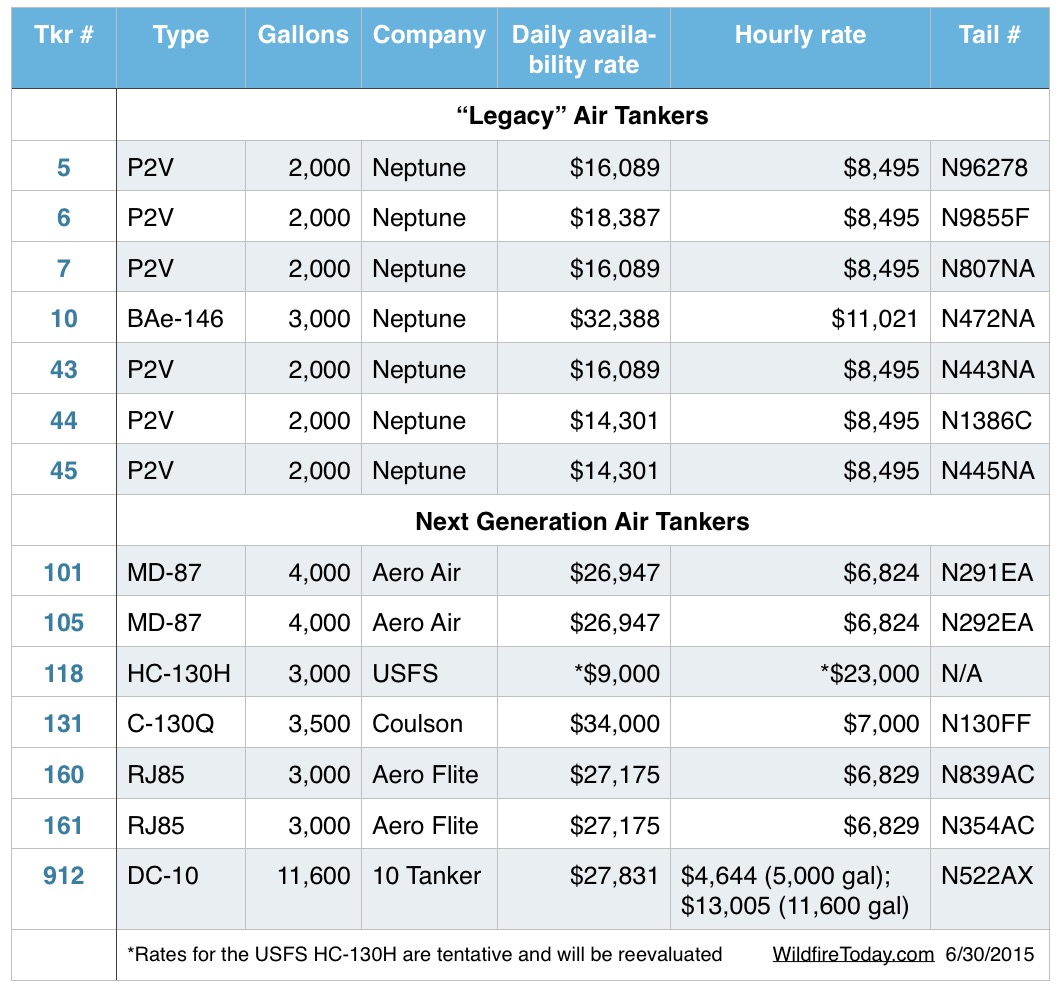All 13 of the large and very large fixed wing air tankers that have been on standard exclusive use contracts since last year have started their Mandatory Availability Period and are on duty. The last two, MD-87s operated by Aero Air, began in the first half of June and should end in mid-December. All 13 air tankers except for three are scheduled to work 160 days. The exceptions are two P2Vs, on duty for 180 days each, and another P2V which is planned for 140 days. All of the P2Vs are operated by Neptune Aviation.
The handful of air tankers that were brought on as “additional equipment” on contracts in 2014 will not be working under the same arrangement this year — the “additional equipment” concept is no longer being used by the Department of Agriculture. Those extra aircraft will have to be employed under new contracts for each air tanker or come on under the Call When Needed contracts that were awarded earlier this month.
The U.S. Forest Service is attempting to issue exclusive use contracts for “up to seven” more next-generation air tankers. The agency hoped to have them working by May 30, but the process came to a screeching halt a couple of months ago.
Two companies, Coulson Aviation and Erickson Aero Tanker, filed protests about this latest round of potential contracts. The protests were lodged with the U.S. Government Accountability Office, the agency with the responsibility of deciding whether the protests have merit, which they are required to do by July 9 for Coulson’s protest and July 17 for Erickson’s. Both companies later amended their original complaints, which complicates the procedure for the GAO, so it is unlikely that anything will be decided much before those mid-July due dates.

A 14th air tanker is expected to be ready to fight fire by the end of July, according to Jennifer Jones, a spokesperson for the U.S. Forest Service. That aircraft is Tanker 118, one of the seven HC-130Hs owned by the Coast Guard that are in the process of undergoing major maintenance and conversion to air tankers.
T-118, Government Owned/Contractor Operated, has been at McClellan Airport for a couple of weeks and is being used, with a lead plane, for training flight crews. It does not have a conventional gravity-based retardant tank, yet, but will be using one of the eight Modular Airborne FireFighting Systems (MAFFS) that use compressed air to force 3,000 gallons of retardant out of the internal slip-in tank. Eventually it and the other six HC-130Hs will have a gravity tank, using the same basic concept employed by all of the Contractor Owned/Contractor Operated large air tankers.
The hourly and daily rates for the HC-130H are estimated at this early stage of deployment of the aircraft, Jones told us.
“The rates are expected to decrease after the program is stood up and the expenses can be spread across multiple aircraft”, she said. “Costs incorporate many aspects of the program, including hangar facilities, U.S. Coast Guard engineering and airworthiness support, maintenance and pilot contracts, and MAFFS maintenance.”
Tanker 118 does not have a tail number yet, since it is still owned by the Coast Guard. Later, possibly this year, it will depart McClellan to finish the conversion to an air tanker, getting the gravity retardant tank and a new paint job– after which the title can be transferred to the USFS.
A second HC-130H will arrive at McClellan in a few months and this year will be used only for training. The other five HC-130Hs will gradually enter the USFS air tanker fleet over the next several years.


Usually, the longer a plane is on contract the less it costs per day and hr. Maybe the RJ is 160-180 where as the 146 is 130-160. Contractors charge more for various reasons, and the main being MAP days. Crew, per diem, other equipment and associated costs etc. Also, extended rates rates vary as well. Say Co. X charges whatever now and that seems high but their extended rates are low. And then Co. Y charges ? that seems reasonable but extended rates are the same as MAP rates. In the end they are all pretty darn close to one another.
The article says—
“All 13 air tankers except for three are scheduled to work 160 days. The exceptions are two P2Vs, on duty for 180 days each, and another P2V which is planned for 140 days.”
Another thing that doesn’t make sense is why is the BEA146 a legacy tanker and the RJ85 is a Next Gen Tanker? Their the same aircraft, except the RJ is half the operating costs.
Some good some bad and some that don’t make sense! Looks pretty one sided. Just don’t understand why a BEA146 gets $32K for sitting on the ground and 11K for flying! Not a very cost effective tanker, for 3,000 gallons yet the government seems top been over backwards on their contract!
Well, there is some shocking bang-for-the-buck discrepancy in that list.
Fuel provided by the government under the next generation contracts, not a cost bid in contract. Not so under legacy contracts. What do you think the cost might truly be? DC10?MD87?C130?